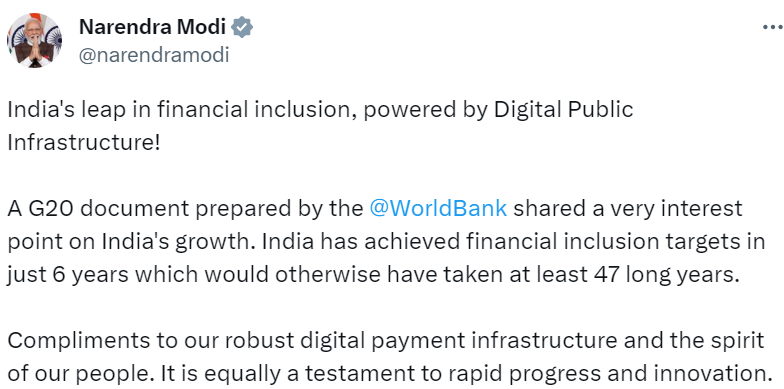- India,
- 08-Sep-2023 02:34 PM IST
World Bank News: Before the G-20 summit, the World Bank has praised the Modi government. The World Bank said in its report that India has achieved the financial inclusion target in just 6 years, which is commendable. Had it run normally, it would have taken at least 47 years. The report further said that India has achieved this feat due to its digital public infrastructure. Sharing the World Bank report on his X account, Prime Minister Narendra Modi wrote that this is the result of the strong payment infrastructure of our government and the strong will of our people. I congratulate our people for this achievement. He further wrote that it reflects our rapid growth and innovation.
Important points of World Bank reportFinancial Inclusion: Appreciating India's Digital Public Infrastructure (DPI) approach, World Bank in its report said that India has achieved that in just 6 years.Jan Dhan-Aadhaar-Mobile (JAM Trinity): The World Bank in its report said that due to the JAM trinity, the rate of financial inclusion has increased from 25% in 2008 to more than 80% for adults in the last 6 years. Thanks to DPI, it took less time than 47 years.PMJDY accounts: The number of Pradhan Mantri Jan-Dhan Account Yojana (PMJDY) accounts has increased by more than three fold from 14.72 crore in March 2015 to 46.2 crore by June 2022. Of these, 56 percent i.e. more than 26 crore accounts are of women.Jan Dhan Plus Program: The Jan Dhan Plus program encourages low-income women to save, resulting in 1.2 crore women joining the scheme (by April 2023). The average balance has increased by 50% in just five months. By enrolling 100 million low-income women in India, India's public sector banks can attract deposits of about 25,000 crores ($3.1 billion).UPI transactions on record: More than 9.41 billion transactions worth approximately Rs 14.89 trillion were done through UPI in May 2023 alone. For the financial year 2022-23, the total value of UPI transactions was about 50 per cent of India's nominal GDP.Easy KYC Process: Digital infrastructure has made the KYC process easy. This has reduced the cost of banks. Banks have reduced their compliance cost from $0.12 to $0.06. The cost reduction made the service more attractive to low-income customers.Payment outside the country through UPI: The facility of making payments outside the country through UPI has also started. UPI-PayNow interlinking has started between India and Singapore. It aligns with the G20's financial inclusion priorities and facilitates faster, cheaper and more transparent cross-border payments. The report states that DPI has opened up huge opportunities for private companies by cutting down on the complexity, cost and time of running the business.

Important points of World Bank reportFinancial Inclusion: Appreciating India's Digital Public Infrastructure (DPI) approach, World Bank in its report said that India has achieved that in just 6 years.Jan Dhan-Aadhaar-Mobile (JAM Trinity): The World Bank in its report said that due to the JAM trinity, the rate of financial inclusion has increased from 25% in 2008 to more than 80% for adults in the last 6 years. Thanks to DPI, it took less time than 47 years.PMJDY accounts: The number of Pradhan Mantri Jan-Dhan Account Yojana (PMJDY) accounts has increased by more than three fold from 14.72 crore in March 2015 to 46.2 crore by June 2022. Of these, 56 percent i.e. more than 26 crore accounts are of women.Jan Dhan Plus Program: The Jan Dhan Plus program encourages low-income women to save, resulting in 1.2 crore women joining the scheme (by April 2023). The average balance has increased by 50% in just five months. By enrolling 100 million low-income women in India, India's public sector banks can attract deposits of about 25,000 crores ($3.1 billion).UPI transactions on record: More than 9.41 billion transactions worth approximately Rs 14.89 trillion were done through UPI in May 2023 alone. For the financial year 2022-23, the total value of UPI transactions was about 50 per cent of India's nominal GDP.Easy KYC Process: Digital infrastructure has made the KYC process easy. This has reduced the cost of banks. Banks have reduced their compliance cost from $0.12 to $0.06. The cost reduction made the service more attractive to low-income customers.Payment outside the country through UPI: The facility of making payments outside the country through UPI has also started. UPI-PayNow interlinking has started between India and Singapore. It aligns with the G20's financial inclusion priorities and facilitates faster, cheaper and more transparent cross-border payments. The report states that DPI has opened up huge opportunities for private companies by cutting down on the complexity, cost and time of running the business.

